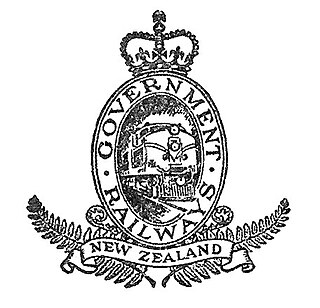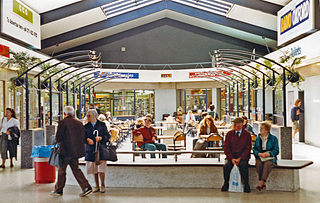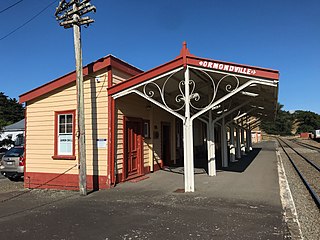
Rail transport in New Zealand is an integral part of New Zealand's transport network, with a nationwide network of 4,375.5 km (2,718.8 mi) of track linking most major cities in the North and South Islands, connected by inter-island rail and road ferries. Rail transport in New Zealand has a particular focus on bulk freight exports and imports, with 19 million net tonnes moved by rail annually, accounting for more than half of rail revenue.

State housing is a system of public housing in New Zealand, offering low-cost rental housing to residents on low to moderate incomes. Some 69,000 state houses are managed by Kāinga Ora – Homes and Communities, most of which are owned by the Crown. In excess of 31,000 former state houses exist, which are now privately owned after large-scale sell-offs during recent decades. Since 2014, state housing has been part of a wider social housing system, which also includes privately owned low-cost housing.
Locomotives of New Zealand is a complete list of all locomotive classes that operate or have operated in New Zealand's railway network. It does not include locomotives used on bush tramways.

Frankton is a central suburb of the city of Hamilton, New Zealand. It is the site of the city's passenger railway station, a major industrial-commercial stretch of State Highway 1C, and a commercial shopping area. Frankton Borough Council was formed in 1913, but merged with Hamilton in 1917, after a poll in 1916.

Hillside Engineering Group is a trading division of the rail operator KiwiRail in Dunedin, New Zealand. Most of its work is related to KiwiRail, but it also does work for the marine industry in Dunedin. On 19 April 2012 KiwiRail announced it was putting Hillside on the market for sale. In November 2012 KiwiRail announced it had sold part of the business to Australian firm Bradken, and the rest would be closed. The workshops continued to be used for some maintenance work by Kiwirail with a skeleton staff. In October 2019, the New Zealand Government announced that it would be investing NZ$20 million into revitalising Hillside Engineering as a major mechanical hub and engineering facility to service Kiwi Rail's locomotives and rollingstock.

The NZR WAB class locomotives were steam locomotives designed, built and used by New Zealand Railways Department (NZR). Their wheel arrangement is described by the Whyte notation 4-6-4T. The locomotives were designed by NZR chief draughtsman S.H. Jenkinson as tank versions of the AB class 4-6-2 Pacific locomotive. Initially, the locomotives were separated into two classes, designated WAB for mainline work and WS for suburban work.

Interislander is a road and rail ferry service across New Zealand's Cook Strait, between Wellington in the North Island and Picton in the South Island. It is owned and operated by state-owned rail operator KiwiRail. Three roll-on roll-off (RORO) vessels operate the 50-nautical-mile route, taking about three hours to complete the crossing.

The New Zealand Railways Department, NZR or NZGR and often known as the "Railways", was a government department charged with owning and maintaining New Zealand's railway infrastructure and operating the railway system. The Department was created in 1880 and was corporatised on 1 April 1982 into the New Zealand Railways Corporation. Originally, railway construction and operation took place under the auspices of the former provincial governments and some private railways, before all of the provincial operations came under the central Public Works Department. The role of operating the rail network was subsequently separated from that of the network's construction. From 1895 to 1993 there was a responsible Minister, the Minister of Railways. He was often also the Minister of Public Works.

Wellington railway station, Wellington Central station, or simply Wellington station, is the main railway station serving Wellington, New Zealand, and is the southern terminus of the North Island Main Trunk, Wairarapa Line and Johnsonville Line.
Milson is a suburb of Palmerston North, Manawatū-Whanganui, New Zealand. The suburb is located to the north of the city, beyond the North Island Main Trunk Rail.

The NZR W class consisted of two steam locomotives built at the Addington Railway Workshops in Christchurch, New Zealand by the New Zealand Railways Department (NZR). They were the first locomotives to be built by NZR.
The Cambridge Branch is a rural railway line in the Waikato, New Zealand. The line stretches from Ruakura Junction for 15.08 kilometres (9.37 mi) to the settlement of Hautapu, having previously continued another 4.19 kilometres (2.60 mi) to the township of Cambridge. It had five stations along its length, at Newstead, Matangi (Tamahere), Bruntwood (Fencourt), Hautapu and the terminus at Cambridge.
The Haywards–Plimmerton Line was a railway development proposed several times between 1879 and the 1960s to connect the Hutt Valley and Porirua areas of Wellington via Haywards.

Longburn railway station was a station in Longburn, on the North Island Main Trunk in New Zealand. The platform, which is across from the Fonterra Factory, remains but the structure has been demolished.

A railway refreshment room is a catering facility attached to a railway station that was formerly common in Britain, Australia, New Zealand, and other countries that were formerly part of the British Empire. They were opened in the 19th century to serve passengers when trains did not convey catering facilities, and thus served passengers en route. Refreshment rooms were similar to tearooms, and generally served a variety of hot drinks, pastries, cakes, and light meals. With the introduction of buffet and restaurant cars, their importance began to decline.
Lichfield is a rural settlement in the South Waikato District and Waikato region of New Zealand's North Island.

Ormondville is a locality in the Manawatū-Whanganui region of New Zealand's North Island. It is located inland, south of Waipukurau and west of Flemington, Hawke's Bay.

The Whakarongo Railway Station was a passenger rail station on the Palmerston North to Gisborne line, in the suburb of Whakarongo in the north of Palmerston North. The station was situated between the Terrace End Station and Ashhurst Station.

Erua was a station on the North Island Main Trunk line, in the Ruapehu District of New Zealand. It served the small village of Erua. For a month in 1908 it was the terminus of the line from Auckland. Makatote Viaduct and tramway are about 3 mi (4.8 km) south of Erua.
















